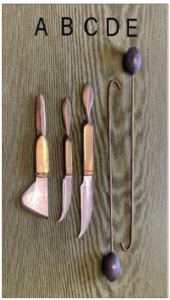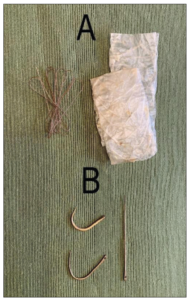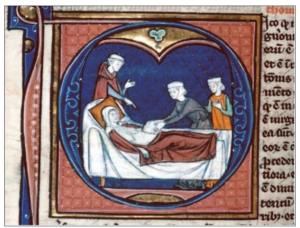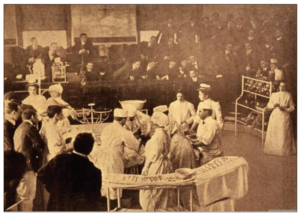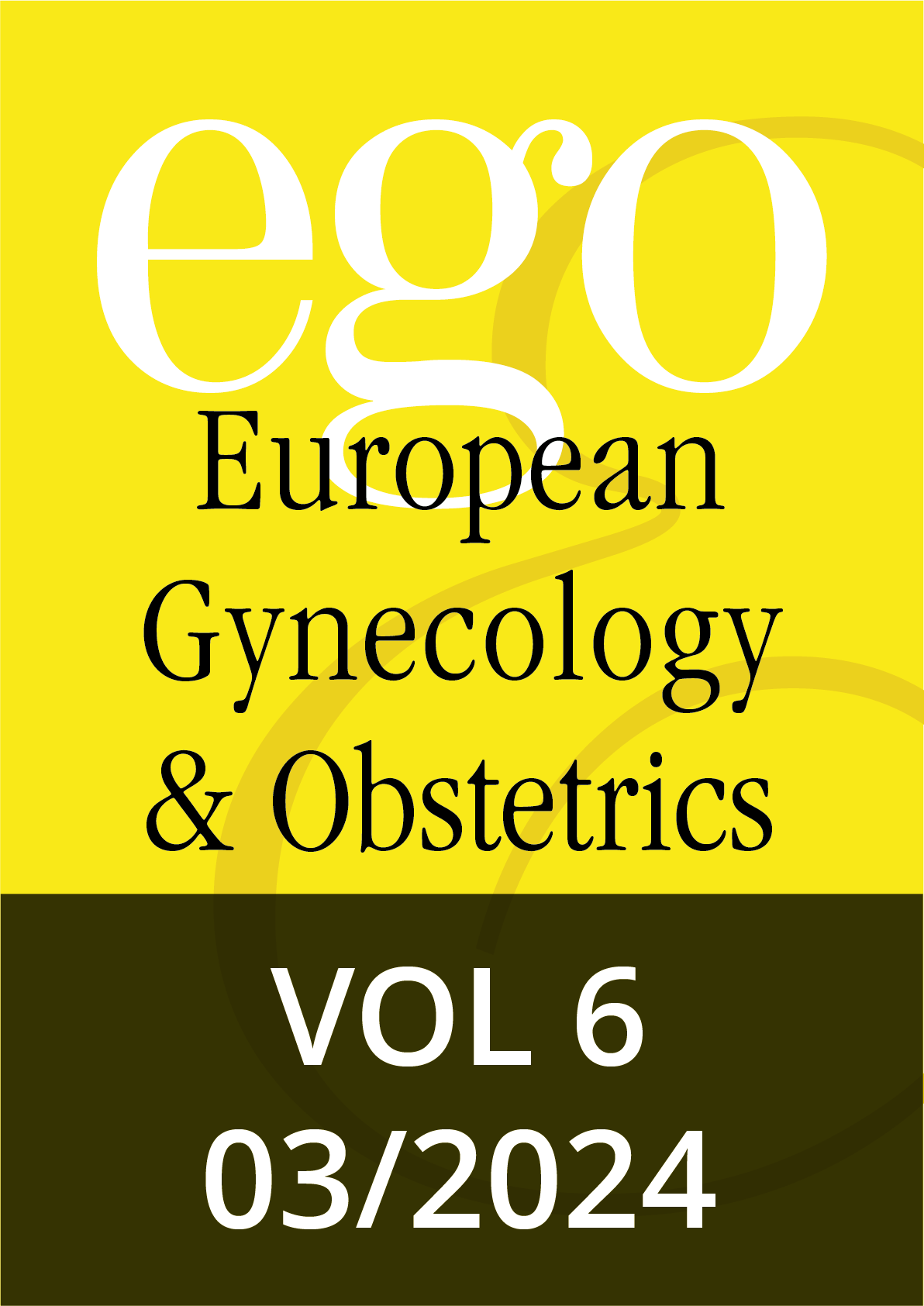Introduction
US Paralympic swimmer, Elizabeth Stone once said: “Making the decision to have a child is momentous. It is to decide forever to have your heart go walking around outside your body”. This was true in the past, it is true today and will continue to be true in the future.
Much has evolved in medicine since the time when the Hippocratic physicians [1] were unaware of the existence of the ovaries, and were convinced that the female reproductive system was made up of two or more cavities known as the womb (synonymous of the uterus). They thought it could move to any other part of the body like an “irrational animal” in search of sexual satisfaction and pregnancy. This “theory”, however absurd may sound to us now, was something they truly believed in [2].
We have to go back to prehistoric times to find the first steps in the noble art of childbirth. For centuries, women had been in charge of attending births, requesting the assistance of a male doctor in the case of complications. However, it has long been debated whether men should play the role of the midwife. It was in France in the 16th century that this discussion took on a new direction. Supporters of male midwives argued that men were more skilled and pointed out that, with few exceptions, it was men who published studies related to the art of obstetrics. Meanwhile, detractors claimed, that those men were groping the most respectable ladies in France. It was the invention of the forceps -a mysterious device- at the beginning of the 17th century, that tipped the balance in favour of men.
Myths and legends
In many ancient cultures, mythological stories shaped beliefs, values and traditions for generations. Their influence is also evident in medicine, providing symbolic explanations of health and disease, offering a framework to understand and address medical issues. References can be found in Greek mythology where the caesarean section is mentioned with relation to the births of gods or demigods, giving this intervention the status of the “way of the gods”, as opposed to the vaginal route, associated with faecal and urinary excretions [3].
The god of medicine, Asclepius (Aesculapius to the Romans), was extracted from the womb of his mother Coronis, killed by the god Apollo after her infidelity was revealed. As she was taken to the pyre for cremation, Apollo himself cut open her abdomen with a dagger. Afterwards, Asclepius was entrusted to the care of the centaur Chiron, who imparted to him the noble art of healing [4]. Dionysus (Bacchus to the Romans), the god of fertility and wine, is known as the “twice-born” god. According to one version, he was the son of Zeus and the Theban princess Semele, a mortal. After Zeus appeared in all his splendour, as proof of his divinity, he stuck Semele with his lightning and she died. Zeus barely had time to open up her womb and remove the premature baby. To complete the pregnancy, he sewed the baby into his own thigh, from where he would be born a few months later, not as a mortal but as a god.
Buddha, who taught the path to Nirvana, according to a legend, was born from the right side of the abdomen of his mother Maya Devi, who had become pregnant after dreaming that a great white elephant had pierced her side with its tusk.
According to the sacred Vedas, the most ancient texts in Indian literature, Indra, lord of the heavens, lightning and air, refused to be born vaginally and was born through a lateral opening in the mother's womb, without a prior cut [5].
There are many historical figures that are said to have been born by caesarean section. In some cases, their true existence is uncertain, and in others, it is difficult to believe that the mother or themselves survived such an operation. Probably the most famous example of a caesarean section survivor is the Roman political and military leader, Gaius Julius Caesar.
Etymology of the word “caesarean”
Etymologically, the Latin words caedere and secare can be translated as “to cut”. However, the word “caesarean” does not have a precise origin and various hypotheses have been put forward, some more plausible than others. According to the legend, a leader and prominent figure of Antiquity, Gaius Julius Caesar was born in Rome by caesarean section to his mother, Aurelia Cota, on 12 or 13 July 100 BC [6]. The earliest reference to this fact can be found in Natural History (Historia naturalis) Book VII, Chapter IX by Gaius Plinius Secundus the Roman writer, known in English as Pliny the Elder, who describes Julius Caesar as the first member of the Caesar family who is said to have been born by the cutting of his mother’s womb. It is important to remember that seven generations earlier, in the 3rd century BC, we find the first of the family with the cognomen Caesar, Numerius Julius Caesar. Roman historians after Pliny the Elder wrongly attributed this form of birth [7] to Gaius Julius Caesar himself and, during the Middle Ages, it was widespread in numerous writings and manuscripts, such as in the “Etymologies” of Saint Isidore of Seville [8]. However, the hypothesis that Gaius Julius Caesar was born by caesarean section is completely inconsistent, since it would have been almost impossible to survive a caesarean section in those times, and besides, Gaius Julius Caesar was the first-born son of Aurelia, who subsequently gave birth to six more children, and was still alive when he said goodbye to her at the door of her house on the morning of the elections for the Pontifex Maximus.
Other assumptions, although less credible, included the idea that the word “caesar” was related to “head of hair”, arguing that the first ancestor with this cognomen had long hair. In antiquity, having long hair was considered a symbol of royal dignity. The Latin word caesi was also related to “elephant hide” in the Punic language, perhaps due to the possibility that one of their ancestors had killed this animal [9].
One of the two most widely accepted hypotheses is the Lex Regia [10] proclaimed by Numa Pompilius, the second king of Rome and the successor of Romulus. His law forbade the burial of a pregnant woman before the baby had been removed from her womb. The purpose of that law was to legalise such an operation in order to try to save the newborn, once the mother died. With the fall of the monarchy, this law became known as the Lex Caesarea. It should be clarified that the reference to this procedure with the term caesarean section was not documented until the start of the Renaissance and was limited to scholars of Roman law.
In 1581, the Duke of Savoy’s personal physician, François Rousset, published the book entitled, “Traité nouveau de l’hystérotomotokie ou Enfantement caesarien” (“New Treatise on Hysterotomotokie or Caesarean Childbirth”). In this work, Rousset refers to a section Caesarienne stating that the word caesar is etymologically related to a caesarean section [11].
According to other authors the term caesarean section derives from the word “secare”; for example this term can be found in the work of French Jesuit, Théophile Raynaud “De ortu infantium contra naturam, per sectionem Ceaesaream” (1637) [12].
Post-mortem caesarean
It seems feasible that the post-mortem cesarean section could have been carried out in prehistoric times, as “flint stone cutting tools” were available and could have been used to make incisions in the abdomen. However, this intervention would have been exceptional, since one and a half million years ago Homo erectus had a smaller skull, with a brain volume of 850 – 1,100 cm³, and a pelvis more similar to that of modern humans. Therefore, the cephalopelvic disproportion, one of the main reasons for performing a caesarean, was very rare.
In Ancient Greece and Rome, caesarean sections were carried out, although they were not common. Hippocrates of Cos (5th century BC), considered the “father of medicine”, Aulus Cornelius Celsus (1st century AD) and Galen de Pergamon (2nd century AD) do not mention this practice in their writings.
Since Theodosius I the Great proclaimed Christianity as the only official religion of the Roman Empire in 380 AD, the influence of the Church became evident. In 533 AD, the Byzantine Emperor Justinian I, promulgated the Digest, a compilation of the Roman laws, thus establishing the practice of caesarean section on the basis of Lex Regia (unlimited authority transferred from the Roman people to the emperor) which was welcomed by the Christian community [13]; according to the newly introduced legislation, from that time on, the caesarean was considered a regular procedure [14]. In fact, children born to mothers who underwent this incision were known as caesones.
This trend of thinking would continue in subsequent centuries and was confirmed at the Councils of Cologne (1280), Vienna (1311), and Paris (1557). The practice of caesarean section was considered necessary in the event of maternal death until the 16th century, provided that there were indications that at response child was still alive, so that they could be baptised and thus their soul could be saved [15].
Caesarean section on a live woman
We can imagine that the practice of caesarean section on live mothers was an extremely dangerous procedure. Lack of medical knowledge and rudimentary surgical techniques meant that the maternal survival rate of those undergoing caesarean sections was exceptional, even nil. Infections, blood loss and other risks associated with the surgical procedure in a non-sterile environment contributed to high mortality rates when those procedures were performed.
We cannot establish with certainty the exact date when the first caesarean section was performed on a live woman. From the 16th century onwards, there have been records of the first caesarean sections performed successfully on a live woman in terms of maternal survival.
In 1500, in Switzerland, a butcher and pig gelder called Jakob Nufer, performed a caesarean section on his wife, Elizabeth Alice Pachin. She is described as having been attended by thirteen midwives for six days without success. In desperation, after seeking permission from the town’s mayor, he took a butcher’s knife, cut open his wife's womb and pulled out their baby. He then sutured the abdominal wound. Both mother and child survived, and she went on to have five more children vaginally. This was recorded in 1582 by the Swiss physician called Gaspard Bauhin.
As already mentioned, in 1581 the publication “Traité nouveau de l’hystérotomotokie ou Enfantement Caesarien” of François Rousset recommends for the first time the performance of caesarean section in live women, when there was a large fetus, a narrow pelvis, a complicated twin pregnancy or intrauterine foetal death [11]. It is important to point out that Rousset never performed a caesarean section; he simply reported 14 successful caesareans, some of which being implausible, such as 6 caesarean sections in the same patient. Moreover, he proposed that the uterine wound should not be sutured, arguing that the uterus would stop bleeding naturally. These erroneous observations were accepted as valid for centuries.
The first well-documented caesarean section on a live woman took place on 21st of April 1610. It was performed by the Wittenberg court surgeon, Jeremias Trautmann, and recorded by Professor Sennert, who was an eyewitness of that event. The patient was the wife of a cooper who suffered a uterine rupture at the end of her pregnancy, as a result of a fatal accident. Although the child managed to survive, the mother died 25 days later due infection [15].
Caesarean sections were performed without the use of anaesthesia and the abdomen was opened outside the rectus muscles in order to preserve the bladder, while the uterus was sectioned longitudinally. After removing the newborn, the uterus was not sutured and the abdominal incision was closed with a few thick stitches and sometimes an ointment was applied.
The high maternal mortality led several esteemed surgeons to raise their voice against the operations on live women. Among those who criticized such procedures there were: Ambroise Paré, a contemporary of Rousset, as well as his disciple, the surgeon of Henri IV, Jacques Guillemeau [16], and the prominent 17th century obstetricians, the German doctor Cornelis Solingen and the French doctor François Mauriceau, who was particularly critical, only allowing caesarean sections to be performed if the mother had died [17].
Developments within caesarean section from the 18th century onwards
The caesarean section became a challenge for doctors. As prejudice decreased, experiments such as hysterectomy on laboratory animals (Joseph Cavallini, 1768) and autopsies on women undergoing caesarean sections were carried out. Those studies revealed that the uterus did not heal spontaneously after being opened up, which led to the conclusion that the lack of sutures was the cause of the internal bleeding.
It was Jean Le Bas, the French professor and the surgeon, who, in 1769, first recommended cross-sectioning and suturing the uterine wound [18]. Unfortunately, this technique was abandoned due to poor results and the risk of severe injuring the uterine vessels.
The forceps [19] appeared in the early 17th century, although there are references indicating that the first person to evidence its use on a live foetus was Jacques Jakob Rueff, in Zurich in 1554.
The invention of this “mysterious device” by the surgeon Peter Chamberlen, deserves to be explained. For many years, Peter Chamberlen kept his invention secret and, to avoidits disclosure, he blindfolded the mother and asked the midwife to leave the room so that the forceps would not be seen. After his death, his son, Hugh Chamberlen, who settled in England, following his business acumen, made his father’s invention public and sold it to all medical students at an exorbitant price.
The use of forceps helped reducing the need for a caesarean section, thus decreasing maternal mortality. Despite efforts to develop new techniques in the practice of a cesarean, such as the first symphysiotomy on a live woman performed in Paris by Jean-René Sigault in 1777 [20], and fetotomy techniques [21], none was as efficient as the forceps in reducing mortality rate.
In 1793, James Barlow, a surgeon from Blackburn in Lancashire, performed the first caesarean section in England of which there is a record of maternal survival. The mother, Jane Foster, had a distorted pelvis as a result of a fracture due to trauma [22].
The 18th century literature reports several cases of successful caesarean sections both in Europe and in other parts of the world, with the largest number of caesarean sections being performed in France.
At the beginning of the 19th century, several authors, such as G. P. Michaelis of Harburg (1809), advocated the hysterectomy as a measure to reduce the risk associated with the caesarean section. In 1824, William Edmund Horner and Philip Syng Physick recommended the extraperitoneal caesarean section, a proposal that was not initially widely accepted, although it laid the foundations for a step forward.
In the mid-19th century, the arrival of anaesthesia revolutionized all surgical procedures. First, nitrous oxide was used; it was later replaced by ether. The next step forward was the discovery of the anaesthetic properties of chloroform, done by a renowned Scottish physician, James Young Simpson [23], who initially used it in obstetrics. The introduction of chloroform rendered the operations safer and more precise, as the doctors could operate with no rush and examine the areas of human body inaccessible until then. Simultaneously, in 1847, the Hungarian physician, Ignaz Philipp Semmelweis, suspecting that puerperal fever was caused by poor hand hygiene of the delivery personnel, elaborated recommendations regarding the practice of hand washing with calcium chloride and then published the results of the experiment [24].
In 1862, the scientist Louis Pasteur proved the existence of bacteria and their role in infections; three years later, the professor of surgery at Glasgow University, Joseph Lister, implemented the sterilisation of the operating theatre with carbolic acid.
In 1894, the American surgeon, William Stewart Halsted, began to recommend the use of surgical gloves at Johns Hopkins Hospital, and this practice spread to other hospitals around the world. All these advances, together with the systematic improvement of caesarean section techniques, contributed to the reduction of high the rate of maternal morbidity and mortality.
The first publication related to hysterectomy after caesarean section dates back to 1868 and describes a surgical intervention performed in Boston by the American Horatio Robinson Storer; in this particular case the woman, who also had a uterine tumour, died three days later [25].
If there is a “before” and an “after” regarding the caesarean section technique, Edoardo Porro’s publication entitled “Della amputazione utero-ovarica come complimento di taglio cesareo” (1876) [26], can be considered a borderline. Porro, a gynaecologist from Padua, performed a cesarean section on Julia Cavallini, a 25-year-old dwarf primipara with a deformed pelvis as a result of rickets suffered in childhood. The woman suffered a haemorrhage, which forced the doctor to perform a supravaginal amputation of the uterus, known as a “radical caesarean section”, leaving the stump of the cervix outside the peritoneum. It was the first successful caesarean section followed by a hysterectomy for both mother and child.
Porro’s operation was perfectioned over the years, which contributed to a decrease in both maternal and neonatal mortality rates. In the first 150 caesareans performed using this technique, the mortality rate was reduced to 55%.
In 1882, the German gynaecologists, Ferdinand Adolf Kehrer and Max Sänger successfully introduced silver and silk sutures for uterine closure after caesarean section. Whilst Sänger made a longitudinal incision in the anterior wall of the uterus, Kehrer made a transverse incision in the lower segment of the uterus (segmental caesarean section). Thus, the uterus was preserved, and this so-called “conservative caesarean section” performed from then onwards, led to a significant decrease in maternal mortality.
The problem of frequent peritonitis caused by the spread of infected products from inside the uterus into the abdominal cavity remained to be solved. To tackle this problem, in 1907 the German gynaecologist Fritz Frank introduced a supravesical extraperitoneal cesarean section, despite it being considered more difficult and presenting a high risk of injury to the bladder [27]. In subsequent years, the extraperitoneal technique was modified by surgeons such as Wilhelm Latzko (1909), Otto Küstner (1912), F.C. Irving (1940) and J.F. Norton (1946), which resulted in a decrease in maternal mortality to 10%.
In 1912, the German gynaecologist Bernhard Krönig argued that the good results were mainly due to the lower segment incision rather than the extraperitoneal route of entry, introducing the low cervical and transperitoneal operation, and from 1945, it was the latter that finally prevailed due to the widespread use of antibiotics.
In 1926, the Scotsman J. Munro-Kerr reintroduced the Kehrer technique by making a curved transverse incision in the lower segment of the uterus. This technique was quickly adopted and became the ideal method during the 20th century, as the lower uterine segment is less vascular and easier to suture. Subsequently, the transverse section of the abdominal wall near the symphysis pubis, known as the “Pfannenstiel incision” was introduced.
In the last five decades, new caesarean techniques have emerged with the aim of reducing the operating time and postoperative mortality, such as the technique developed by Sidney Joel-Cohen in 1972 and its subsequent modifications, including Michael Stark’s technique, introduced in 1994.
Current status of the caesarean section
Currently, maternal mortality rate associated with the caesarean section is low in the range of 0.1 to 0.16% [28], which has been accompanied by an increase in the global caesarean section rate. According to the 2021 report of the World Health Organisation (WHO), 20% of babies are born by caesarean section worldwide, and it is anticipated that by 2030 this figure will increase to 29%. However, this increase in the caesarean section rate does not correlate with a clear decrease in maternal or neonatal morbidity and mortality. In Spain [29,30], according to data from the National Institute of Statistics (INE), the caesarean section rate between 2010 and 2018 was 25%, being higher in the private health system than in the public one.
In 1985, the WHO recommended that, “there is no justification for a caesarean section rate higher than 10-15%”, a figure that according to the international community now needs to be revised [31]. The WHO 2015 guidelines state that, “every effort should be made to perform caesarean sections in all women who need them, rather than trying to achieve a specific rate” [32] and they proposed the use of the Robson classification system as a global standard for assessing and comparing caesarean section rates [33,34].
Currently, different aspects such as socioeconomic, cultural, medical-legal and biomedical factors influence the indication for a caesarean section, and there is a lack of clear and homogenous medical criteria. Therefore, guidelines and protocols are needed [35]. Moreover, in recent years, greater importance has been put on allowing the mother to participate in decision-making of a caesarean section, providing her with information in an understandable way, thus enabling her to decide responsibly.
Conclusion
The caesarean section is a surgical procedure as old as humanity itself. In addition to being one of the most enduring operations in history, its implementation and evolution had been strongly influenced by myths, legends and religions, which often generated the most dramatic scenarios that we have had to face in the noble art of medicine.
Over the last three centuries, aside from these influences, this surgical intervention has undergone a true technical evolution, overcoming the high morbidity and mortality rates - the notorious signs of the past. Today, when properly indicated, the caesarean section is probably one of the most life-saving surgical interventions and it will be with us until the end of time.
Conflict of interest
The author declares having no conflicts of interest in relation to this article.
